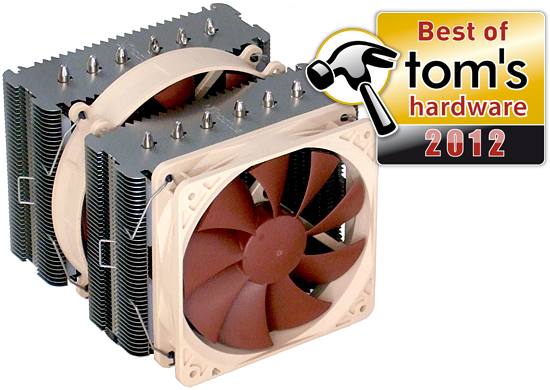Four New Closed-Loop Liquid Coolers Versus Noctua's NH-D14
Four new closed-loop liquid coolers seek to improve thermal performance in a number of ways. We certainly understand the benefits of these configurations, but can they out-do the reigning air-cooling champion, Noctua's NH-D14? Check out our benchmarks.
Four More Closed-Loop Coolers Take On Big Air
The latest closed-loop CPU coolers help push your stable overclocks to new heights, while quieting your PC to a soft, unobtrusive whirr. At least, that's what we're meant to believe. In practice, we've had a tough time demonstrating how this latest generation differs from the models that came before. The issue is that the physics of cooling haven’t changed. Though more exotic materials help transfer thermal energy from one component to another more efficiently, increasing airflow over a larger surface area remains the key to dissipating that heat from a radiator to the surrounding air.
More surface area is where liquid cooling gets its advantage. No longer limited to space above the CPU, where conventional heat sinks do their work, liquid cooling radiators can grow to fill whatever mounting surface you can free up inside your case. And they aren't limited by the amount of weight your processor interface supports, either. Liquid coolers can have as many fins and tubes as your manufacturer of choice can fit into that larger space. Radiators can even be moved into a cooler airstream, compelling some case designers to place mounting locations on their front panels or hard drive cage.
Increasingly, low-cost manufacturing makes closed-loop cooling an affordable option for many mid-budget builds. The technology still has two problems to overcome, though. First is that the displaced fans usually leave a hot voltage regulator on the motherboard. The second problem is that they still have trouble outperforming equally large (and dangerously heavy, if you build and ship your own machines) CPU-mounted designs. Today’s closed-loop coolers have solutions for both concerns.

Cooler Master tries to solve the debate about size by making its 280 mm cooler bigger than just about any air cooler we've seen. Zalman takes stab at the voltage regulator cooling problem by using an un-shrouded fan, which blows air in more directions than straight forward. SilverStone attempts to address both issues by making its 240 mm radiator nearly twice as thick, and then recommending that its fans be installed upside-down so that they blow towards the motherboard.
| Closed-Liquid CPU Cooler Features | ||||
|---|---|---|---|---|
| Row 0 - Cell 0 | Cooler Master Nepton 280L | SilverStone Tundra TD02 | Thermaltake Water 3.0 Pro | Zalman Reserator3 Max |
| Length | 12.2" | 10.9" | 5.9" | 5.9" |
| Width | 5.6" | 4.9" | 4.7" | 4.8" |
| Rad. Thickness | 1.2" | 1.8" | 1.9" | 2.0" |
| Cooling Fans | 2 x 140 x 25 mm | 2 x 120 x 25 mm | 2 x 120 x 25 mm | 1 x 120 x 25 mm |
| Total Thickness | 2.2" | 2.8" | 4.1" | 3.1" |
| Control Type | Motherboard Fan Headers | Motherboard Fan Headers | Motherboard Fan Headers | Motherboard Fan Headers |
| Weight | 51 Ounces | 63 Ounces | 35 Ounces | 31 Ounces |
| AMD Sockets | All 4-bolt (AM2 to FM2) | All 4-bolt (AM2 to FM2) | All 4-bolt (AM2 to FM2) | All 4-bolt (AM2 to FM2) |
| Intel Sockets | All 4-bolt (775 to 2011) | All 4-bolt (775 to 2011) | 115x, 1366, 2011 | All 4-bolt (775 to 2011) |
| Web Price | $120 | $120 | $90 | $100 |
Socket-mounted coolers are most common, so we clamped on our most popular competing sample. At 47 ounces, the award-winning SE2011 (LGA 2011) version of Noctua’s NH-D14 exemplifies our cautions concerning dangerously heavy CPU-mounted designs.

Stay On the Cutting Edge: Get the Tom's Hardware Newsletter
Get Tom's Hardware's best news and in-depth reviews, straight to your inbox.
Current page: Four More Closed-Loop Coolers Take On Big Air
Next Page Cooler Master Nepton 280L-
squirrelboy length, width and thickness in inches, fan size in mm, weight in ounces. can we just have mm everywhere, and preferably kg as well?Reply -
razor512 Seems they reduced their old BS claim of handling 400 watts of heat on the Reserator 3 MAX, it is now 350 watts, but even that seems unrealistic.Reply
Tomshardware should place some of these coolers on a resistive load of 300-400 watts and see if these coolers can actually handle the heat, or will the fluid boil and build up enough pressure to pop. -
xiinc37 Isn't the whole point of watercooling to move the cooler far away from the cpu, so that there is more room to utilize a significantly larger radiator? The thermalright and zalman options look smaller than the noctua...Reply -
rmpumper Grabbed a Dark Rock Pro 2 for my new setup. No regrets - looks a billion times better than D14, is less noisy, performs +-1C the same.Reply -
ingtar33 got an old corsair h100 for $50, which was less then the old heatsink i had on my phII x4 965 used to go for (thermalright ultra 120), Gained a solid 8C improvement in temps, lost some of the noise advantages (the ultra had two noctua's on it)... setting it to medium gave me a 5C improvement in temps, and about the same noise levels. overall i'm pretty happy with it. it looks cleaner, that's for sure.Reply -
bigcyco1 Thanks for the review.I always have said if someone is going to watercool they should go custom.IMO those all in one water cooling kits just are not worth it. They are no better than high-end air cooling like a Noctua D14, Thermalright Silver Arrow,Phanteks PH-TC14PE elect.If you want to go water cooling do a custom loop if not just go with top of the line air cooling.Better bang per buck!Reply -
itzsnypah I wish there was some way to measure the DeltaT of the Ethylene Glycol used in these CLC's because truthfully I wouldn't be surprised to see >25c when using a overclocked 3960X.Reply -
ChromeTusk I wonder how much the rear exhaust fan would have affected the Reserstor3’s results.Reply
In any case, I will wait for price drops or rebates. -
djorgji Is it so difficult to sort the results from best to worst? Lowest to highest etc?Reply
Like this it is impossible to read. -
nilfisktun Well, those stock fans all blows, in my optic. You might call it cheating, but try slamming in two noctua pwm fans in a H100i for instance. I run this at home, and those fans typically runs at 600-800 rpm, therefore being totally silent. My stock temps rest around 38C, with 22C ambient, and hit around 60C at full prime load. i7 2600K @ 4.2 ghz. 1.28vReply
